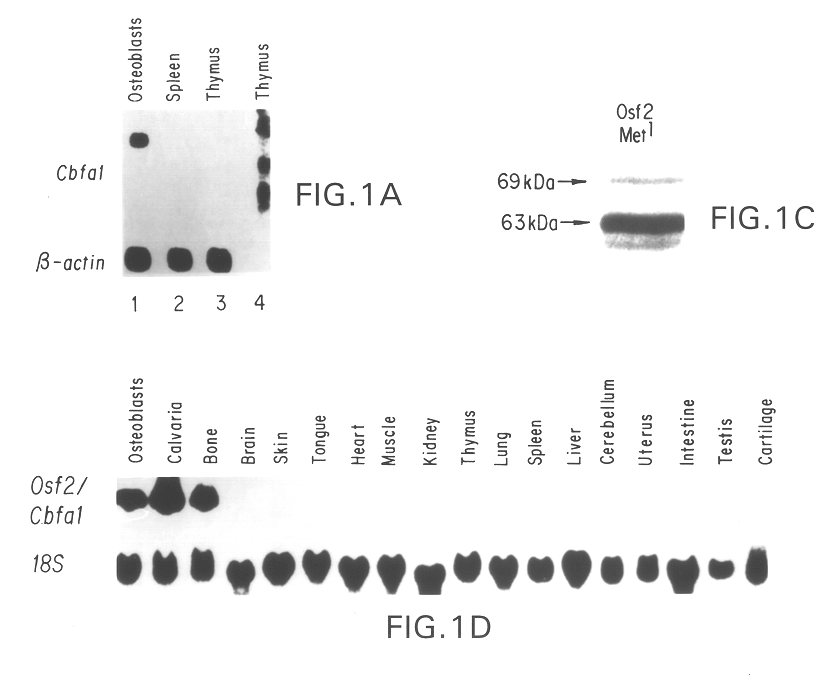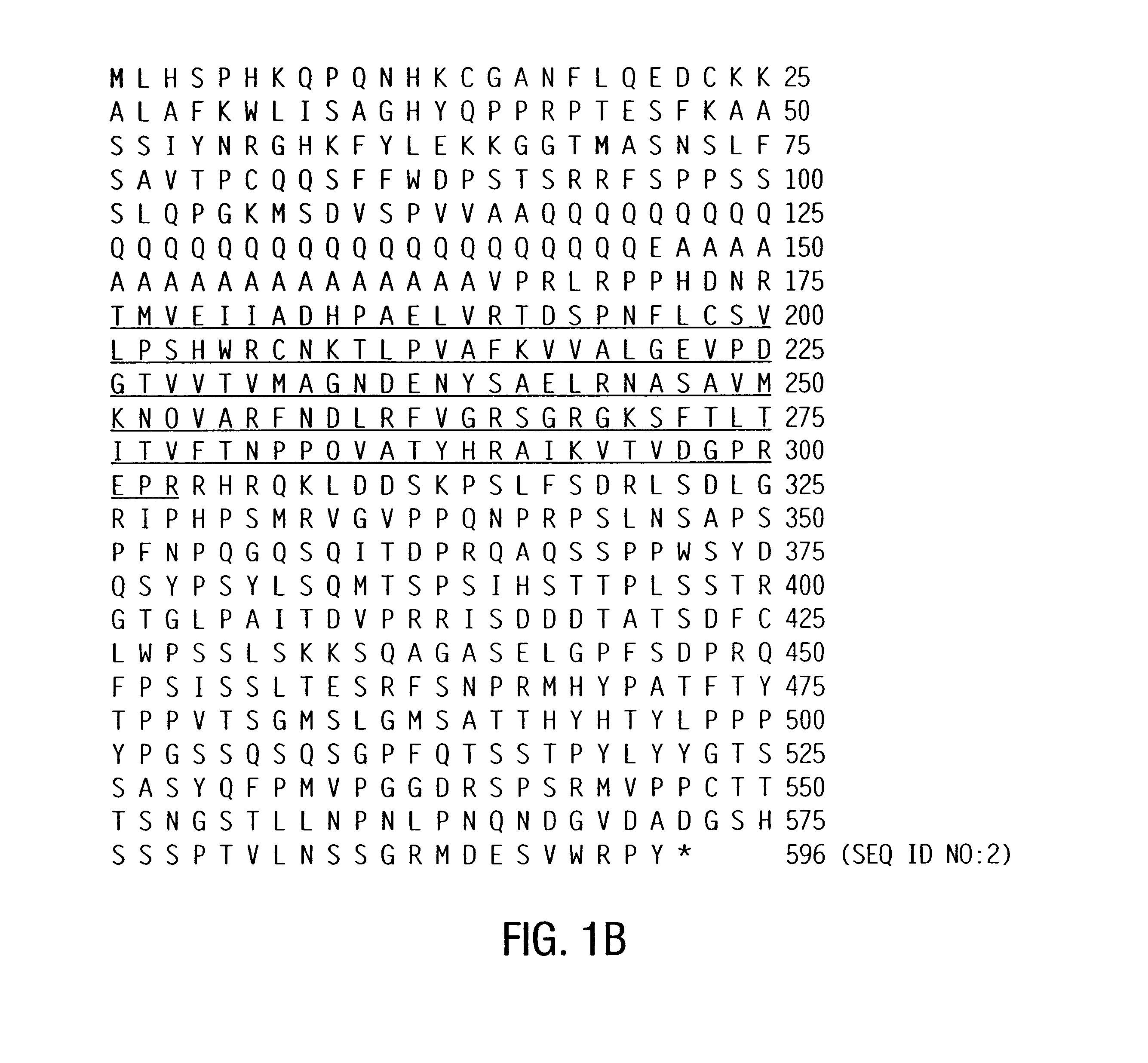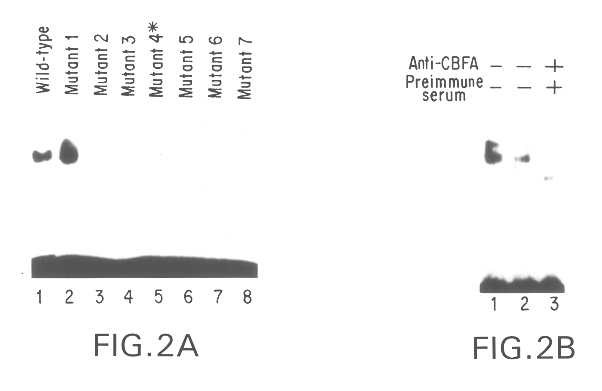Osf2/Cbfa1 nucleic acids and methods of use therefor
a technology of cbfa1 and nucleic acids, applied in the field of molecular biology, can solve the problems of inability to regulate the transcription of genes involved in skeletogenesis, and achieve the effect of enhancing the immunogenicity of a particular immunogen composition
- Summary
- Abstract
- Description
- Claims
- Application Information
AI Technical Summary
Benefits of technology
Problems solved by technology
Method used
Image
Examples
example 2
5.2 Example 2
Genomic Organization, Expression of the Human CBFA1 Gene
The runt / Cbfa gene family is highly conserved between Drosophila and human (Kagoshima et al., 1993; Ogawa et al., 1993a,b). These genes encode transcription factors whose DNA binding domain, the runt domain, is a 128 amino acid polypeptide whose amino acid sequence is highly conserved between Drosophila and human proteins. Three human CBFA genes, CBFA1, CBFA2 and CBFA3, have recently been identified (Levanon et al., 1994; Ahn et al., 1996; Wijmenga et al., 1995). CBFA2, formerly known as AML-2, has been the focus of many investigations since it is disrupted in the t(8;21) translocation observed in some forms of acute myelogenous leukemia (Speck and Tracy, 1995; Nucifora and Rowley, 1995; Ito, 1996). Consistent with this clinical observation, deletion of the Cbfa2 gene through gene targeting in mice leads to an arrest in hematopoiesis early during development (Wang et al., 1996a,b).
example 1
described the important biological properties of another member of this family, CBFA1. It showed that Osf2 / Cbfa1, a transcript of the mouse Cbfa1 gene is an osteoblast-specific transcription factor that controls the expression of many genes expressed in osteoblasts and can induce osteoblast differentiation of nonosteoblastic cells. Otto et al. (1997) showed that the deletion of the Cbfa1 gene in mice leads to a total absence of osteoblasts due to an arrest in their differentiation. Cbfa1 maps to mouse chromosome 17 and to human chromosome 6p21 (Bae et al., 1995; Levanon et al., 1994). Cleidocranial dysplasia (CDD), a defect in skeletal ossification, has been mapped to these chromosomes in mouse and human, respectively (Sillence et al., 1987; Mundlos et al., 1995). CCD is an autosomal dominantly inherited generalized skeletal disorder characterized by aplasia of the clavicles, delay in closure of the fontanelles and cranial sutures, brachycephalia, prognathism, irregularities in dent...
example 3
5.3 Example 3
Expression Cloning in E. Coli
Based on the Southwestern assay it is possible to perform a Southwestern screening of a bacterial expression library. In this assay a cDNA library is cloned into a bacterial expression vector and screened with labeled monomers or multimers of OSE2. The library is plated and 5 protein-fusion expression is induced by incubation on filters impregnated with IPTG. A .sup.32 P labeled single or concatenated wt OSE2 oligonucleotide is used to probe the filters, using the same buffer as the one used in GRA. Positive phage clones are replated and probed as for the first screening until they reach 100% purity. The specificity of binding of positive clones is tested on a fourth screening by probing filters with the wt probe and its mutated version(s), to determine whether the positive clones isolated fail to bind to multimers of a mutated OSE2 sequence.
PUM
| Property | Measurement | Unit |
|---|---|---|
| Nucleic acid sequence | aaaaa | aaaaa |
| Immunogenicity | aaaaa | aaaaa |
| Affinity | aaaaa | aaaaa |
Abstract
Description
Claims
Application Information
 Login to View More
Login to View More - R&D
- Intellectual Property
- Life Sciences
- Materials
- Tech Scout
- Unparalleled Data Quality
- Higher Quality Content
- 60% Fewer Hallucinations
Browse by: Latest US Patents, China's latest patents, Technical Efficacy Thesaurus, Application Domain, Technology Topic, Popular Technical Reports.
© 2025 PatSnap. All rights reserved.Legal|Privacy policy|Modern Slavery Act Transparency Statement|Sitemap|About US| Contact US: help@patsnap.com



